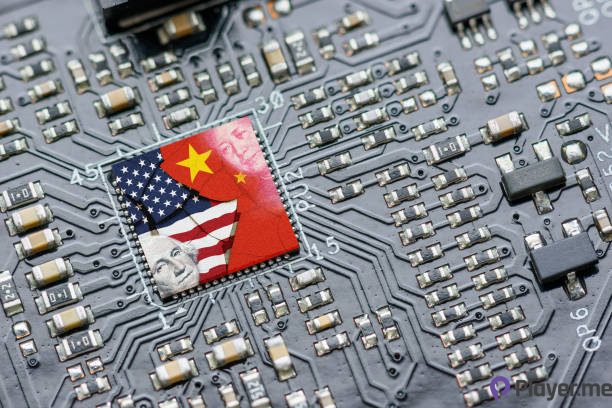In a strategic move aimed at bolstering the United States’ competitive edge, the Pentagon unveiled its latest data and Artificial Intelligence (AI) strategy on November 2. The initiative is designed to enhance battlefield decision-making capabilities, ensuring a more agile response to the evolving global landscape, particularly in the context of the strategic competition with China.
Related: Pentagon Looking to Develop Fleet of AI Drones, Systems to Combat China
Decisive Decision-Making Through AI Integration
Deputy Defense Secretary Kathleen Hicks emphasised the primary objective of integrating AI into U.S. military operations: To improve decision advantage. The focus is on accelerating the speed of commanders’ decisions and enhancing the quality and accuracy of those decisions, ultimately playing a decisive role in deterring and winning conflicts. Hicks stressed the importance of responsible and swift integration, highlighting the critical role AI-enabled systems can play in ensuring national security.
While acknowledging the strategic competition with China, Hicks clarified that the U.S. does not seek an AI arms race with its “Strategic competitor”. Instead, the emphasis is on leveraging AI for national defence without escalating unnecessary tensions.
Potential and Policy Recommendations for Generative AI
The Pentagon’s task force on AI launched in August reflects a broader acknowledgment of AI’s potential across various government activities. A Special Competitive Studies Project (SCSP) report highlights the need for increased federal spending on research and development to position the U.S. as a global leader in setting norms for generative AI development and usage.
Generative AI holds promise in diverse areas, from accelerating drug discovery and enhancing cybersecurity solutions to improving computer networking and public understanding. However, the report underscores the potential risks, including cyberattacks, the development of bioweapons, and effective disinformation campaigns in the wrong hands.
Also Read: Will AI Be Truly Safe? AI Influencers Discusses AI Regulation Law and Debate in Rare Submit
Challenges and Recommendations for U.S. Leadership
To maintain leadership in AI development, the U.S. must lead efforts to establish responsible rules for AI development domestically and internationally. The report recommends increasing federal R&D funding to one percent of the total U.S. GDP by 2026, calling for an $83 billion increase over the next two years.
Diplomacy is identified as a crucial arena for AI integration, with suggestions to leverage existing data and tools within government agencies to gain new insights into foreign policy. The report emphasises the importance of preventing adversaries, particularly China, from manipulating political discourse using generative AI. Proposals include establishing a monitoring body to identify and address incidents related to synthetic media and federal elections.
Also Read: AI Companies in the U.S. Embrace Safeguards: A New Agreement
Global Collaboration and Regulatory Frameworks

International cooperation, especially with China, is essential in addressing global risks associated with generative AI. The report suggests integrating discussions on AI into various diplomatic dialogues to foster strategic stability. However, before such a multi-faceted approach can be realised, the U.S. must establish regulatory frameworks around AI and rebuild trust between the public and technology sector leaders.
While the European Union proposes comprehensive AI regulations, China operates without similar restrictions, raising considerations for U.S. firms operating in international markets. The need for transparency in AI systems is emphasised to increase public trust.
You Might Also Like: Britain’s Big AI Summit Is a Doom-Obsessed Mess
U.S. Challenges and Opportunities in the AI Race
Despite the rush among major powers to strengthen their militaries through AI, the U.S. faces certain challenges, including the fusion of military aims with civilian commercial industry — a strategy China employs. China’s ability to disregard privacy concerns and civil liberties provides a unique advantage in rapidly gathering data and developing capabilities. In contrast, leading U.S. tech companies, such as Google, currently refrain from collaborating with the U.S. military on AI initiatives.
Navigating the intricate landscape of AI competition presents challenges and opportunities for the U.S. The Pentagon’s commitment to responsible AI integration underscores the gravity of maintaining technological leadership and strategic advantage. As the global race in AI intensifies, the need for a comprehensive and forward-thinking approach becomes increasingly evident.
The Role of Generative AI: Opportunities and Risks
Generative AI, a focal point of the Pentagon’s recent task force, emerges as a pivotal technology with the potential to revolutionise various facets of government activities. The SCSP report highlights the wide-ranging applications of generative AI, from expediting drug discovery and bolstering cybersecurity to enhancing computer networking and public understanding. However, the transformative power of generative AI comes with inherent risks that necessitate a proactive and responsible approach.

The report lays out comprehensive recommendations for policymakers to address the challenges and harness the opportunities presented by generative AI. A fundamental suggestion is for the U.S. to take the lead in convening stakeholders to establish responsible rules for AI development domestically and internationally. This proactive stance is crucial in shaping the ethical framework that will govern the evolution of generative AI.
Building a Robust Defensive Mechanism
Recognising the dual nature of generative AI, the report underscores the importance of building a robust defensive mechanism against potential adversarial use. As generative AI advances, the risk of cyberattacks, the development of bioweapons, and sophisticated disinformation campaigns loom large. The establishment of a monitoring body is proposed to track incidents related to synthetic media and federal elections, providing a proactive means of countering adversarial AI activities.
The defensive strategy also extends to preventing adversaries, particularly China, from manipulating political discourse. This entails creating a governmental body to identify and call out media and influence campaigns generated by AI entities. Learning from past challenges in countering disinformation, the proposed AI monitoring body aims to act as a public service, mitigating risks associated with synthetic media without getting entangled in complex political dynamics.
You Might Be Interested In: Tencent’s Ambitious Expansion: “Hunyuan” AI Model Enters Extensive Testing Phase
Elevating Diplomacy Through AI Integration
The intersection of AI and diplomacy emerges as a key area of focus in the quest for global leadership in AI. Leveraging generative AI in diplomatic efforts presents an opportunity to enhance the execution of statecraft.
Joe Wang, the senior director for foreign policy at SCSP, envisions the adoption of new tools into government operations, utilising existing data and tools from various government agencies. This approach aims to reveal new insights into how the U.S. engages with other nations, adding a layer of sophistication to foreign policy decisions.
The report advocates for a proactive approach to engaging with global partners, emphasising the need to integrate discussions on generative AI into various diplomatic dialogues. Strategic stability in the evolving AI landscape necessitates dialogue on shared global risks, echoing the diplomatic approaches employed during the Cold War. The suggestion is to incorporate generative AI as a prominent agenda item in discussions between the U.S. and China, fostering a collaborative approach to address mutual interests and prevent misuse of AI technologies.
U.S. Economic Considerations and Technological Edge

The competitive landscape in AI extends beyond military considerations to economic dimensions. While the European Union proposes sweeping AI regulations that could potentially limit the future development of AI, China operates without similar constraints. The report acknowledges the need for the U.S. to be aware of international efforts without necessarily mirroring them.
Will Moreland, a director for foreign policy at SCSP, highlights the economic implications, emphasising the importance of U.S. firms operating in international markets and generating revenue for research and development.
Rama Elluru, the senior director for SCSP, underscores the role of transparency in increasing public trust. Even small measures, such as informing the public when interacting with an AI system, contribute to building confidence in AI technologies. As the U.S. navigates the intricate landscape of AI development, considerations of economic competitiveness and public trust become integral components of the overall strategy.
Shaping the Future of AI and Global Security
The potential benefits of generative AI must be harnessed responsibly, with a keen awareness of the associated risks. Building domestic and international trust is a must to ensure the ethical development and deployment of AI technologies.
The path forward requires a delicate balance between maintaining technological leadership, fostering economic competitiveness, and addressing global concerns. The Pentagon’s strategic approach underscores the recognition that AI is not merely a technological race but a defining factor in the future of international relations and security.
Author Profile
Latest entries
 GAMING2024.06.12Top 4 Female Tekken 8 Fighters to Obliterate Your Opponents in Style!
GAMING2024.06.12Top 4 Female Tekken 8 Fighters to Obliterate Your Opponents in Style! NEWS2024.03.18Elon Musk’s SpaceX Ventures into National Security to Empower Spy Satellite Network for U.S.
NEWS2024.03.18Elon Musk’s SpaceX Ventures into National Security to Empower Spy Satellite Network for U.S. GAMING2024.03.17PS Plus: 7 New Games for March and Beyond
GAMING2024.03.17PS Plus: 7 New Games for March and Beyond GAMING2024.03.17Last Epoch Necromancer Builds: All You Need To Know About It
GAMING2024.03.17Last Epoch Necromancer Builds: All You Need To Know About It





